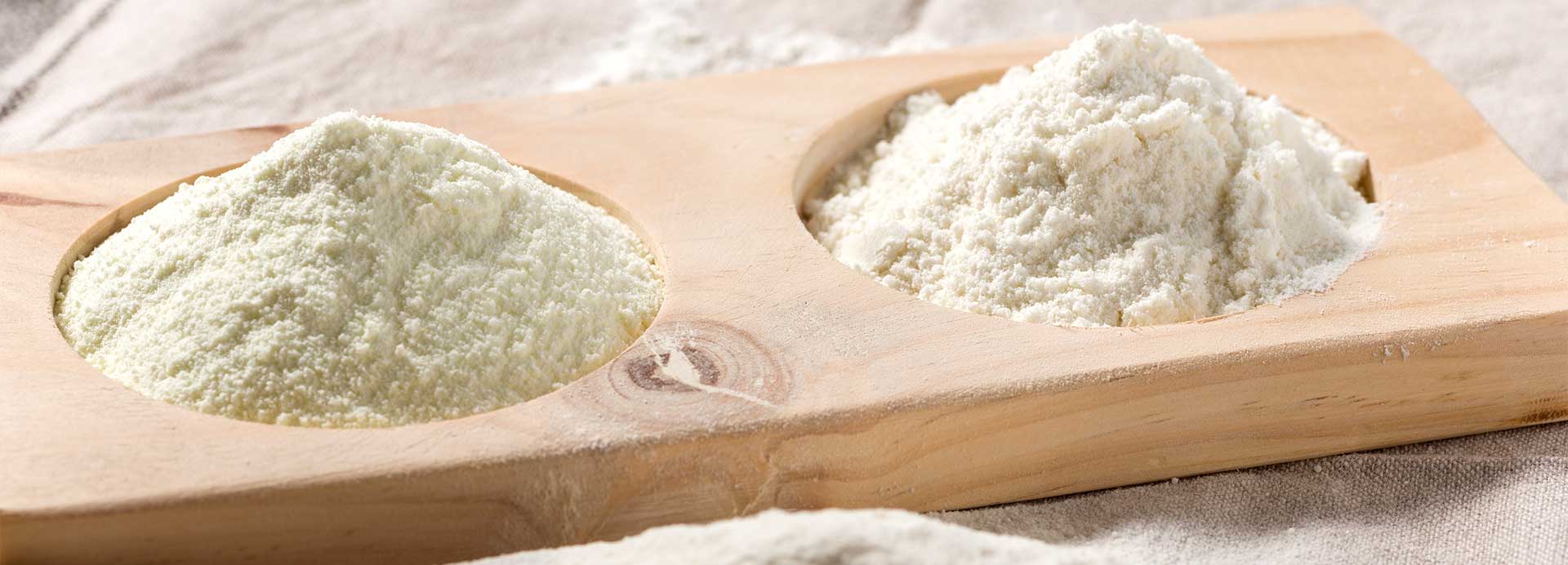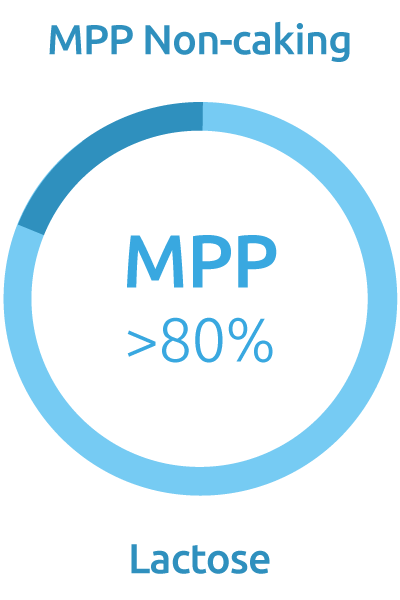Whey (or serum), the yellow-green liquid part of milk, was considered dairy waste for many years owing to disposal issues caused by its high organic matter1 . Yet, whey proteins are now valued for the beneficial compounds that they contain. They are abundant in essential amino acids, like leucine, valine, and isoleucine, and are frequently included in commercial food products, especially in the dairy industry2 .
Due to the health advantages associated with its bioactive components, whey proteins have recently been the subject of study into their possible use in functional foods2 . A distinct function and mode of operation are attributable to each individual component.
For example, the β-lactoglobulins found in whey account for half of the dairy ingredient2 . It is the milk protein with the highest level of essentials amino acids and with 28% of branched amino acids (BCAA). In addition, they are an excellent source of cysteine, an essential amino acid necessary for the formation of glutathione, the main intracellular antioxidant3 . Moreover, β-lactoglobulins are associated with whey protein suppression of angiotensinconverting enzyme3 .
α-lactalbumin, the second abundant fraction, is also rich in essential amino acids. It sequence of amino acids shows significant homology with egg white lysozyme but also with human αlactalbumin. It contains high levels of tryptophan, which can increase brain serotonin levels and so enhances the psychological health of patients under stress.
The role of whey proteins in oxidative stress
Many disorders have been linked to oxidative stress, according to studies4 . Constant oxidative stress contributes to the development of disorders, including neurological diseases, cancer, and aging, as well as diabetes and cardiovascular disease4 .
The free radicals produced during metabolic processes are to blame for this, and antioxidants and antioxidant systems are what keep this from happening4 . Whey proteins are effective in scavenging free radicals, stopping lipid peroxidation, and binding transition metal ions3 . As cysteine is abundant in whey proteins, it can contribute to the body’s glutathione levels, help protect against reactive oxygen species, and provide electrons to enzymes such as the glutathione peroxidase2,3,5 .
Effects of whey proteins on insulin sensitivity and satiety
The condition known as obesity, in which excessive fat accumulation in the body, may increase the risk of various diseases, as well as disability and death6 . This has become a great public health issue across the globe, prompting researchers to look for bioactive compounds that might increase satiety while decreasing energy intake7 .
Studies have shown that whey proteins may help reduce obesity by boosting insulin sensitivity and satiety7 . For instance, in a study, 50 grams of whey protein concentrate were given to people with well-controlled type 2 diabetes before a high glycemic meal; this improved the prandial insulin response and raised levels of glucagon-like peptide 1, a protein that signals the pancreas to release insulin and slows the rate at which stomach empties8 .
Increases in satiety hormones such as glucagon-like peptide 1 and peptide YY, a hormone that helps the body to feel satiety communicating with the brain, were also seen in a randomized trial of young obese women who consumed 45 grams of whey protein isolate 7 .
The role of whey protein in hypertension
Cardiovascular diseases are the leading cause of mortality, and hypertension is one of its modifiable risk factors9 . Thus, treatment aimed at reducing blood pressure is an integral part of cardiovascular disease care9 .
Angiotensin I converting enzyme (ACE) regulates blood pressure by producing the chemical called angiotensin II, a molecule that may cause vasoconstriction by narrowing blood vessels10 . Natural compounds, such as whey proteins, have been the focus of research for their potential to inhibit ACE activity and thereby reduce the formation of angiotensin II10 . The ACE enzyme is inhibited by the lactokinins, the sequence of peptides founded αLactalbumin and ß-Lactoglobulin, which may explain why people who consume more of it have a decreased risk of hypertension10 . In addition, research shows that those who are overweight or obese who consume whey protein have lower blood pressure11 .
The role of whey protein in Immunity
Many components present in whey proteins and especially in colostrum help the newborn, whose immune system is immature, to defend themselves against viral and bacterial infections. This defence involves immunoglobulins and iron-binding proteins like the lactoferrin.
The protective role of immunoglobulins in breast milk is well-documented. Immunoglobulins protects infants against infection, shapes the microbiota and creates a non-inflammatory response against the microbiota, thus preventing intestinal inflammation. Bovine Immunoglobulins found in whey proteins has a number of similar effects: binding to humanrelevant pathogens, effects on phagocytosis and prevention of infection in human studies. Lactoferrin, also known as lactotransferrin, belongs to the innate immune system. Apart from its main biological function, namely binding and transport of iron ions, lactoferrin also has antibacterial, antiviral, antiparasitic, catalytic, anti-cancer, and anti-allergic functions and properties.
Milk proteins have been studied for presence of bioactive amino acid sequences since late 1970s and are now considered the most important source of bioactive peptides. The past decade has seen an exponential increase in milk protein’s research. In foods, the search for bioactive peptides has mostly been carried out using bioinformatic and in vitro approaches, although some food complements containing whey proteins fractions have already been seen in the market.
References:
1. Sharma R. 2019 Academic Press; p. 637–63.
2. Minj S. and Anand S. 2020 Dairy;1(3):233–58.
3. Mehra R. et al. 2021 J Funct Foods;87:104760.
4. Corrochano A.R. et al. 2018 J Dairy Sci;101(6):4747–61.
5. Liu T. et al. 2022 J Biochem Mol Toxicol;36(1):e22942.
6. Haidari F. et al. 2020 Trials;21(1):1–10.
7. Rigamonti A.E. et al. 2019 Nutrients;11(2):247.
8. Jakubowicz D. et al. 2014 Diabetologia;57(9):1807–11.
9. Chamata Y. et al. 2020 IJMS;21(3):864.
10. Li X. et al. 2022 Food Biosci;48(101737):101737.
11. Yang J. et al. 2019 Food Sci Nutr;7(5):1857–64.
12. Lam F.C. et al. 2019 Front Pharmacol;10(317):317.
13. Zhao C. and Ashaolu T.J. 2020 Lwt;134:109935.
14. Graf S. et al. 2011 Curr Opin Clin Nutr Metab Care;14(6):569–80.














